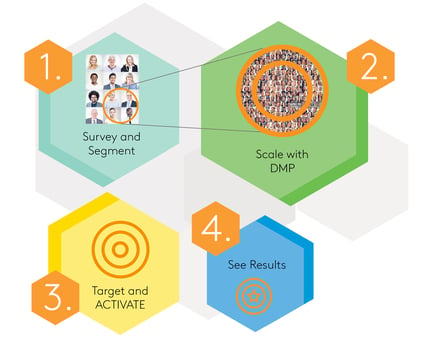As researchers, we have a wide range of people to please, from internal stakeholders, to external clients, to our consumers. We have budgets to be mindful of, investments to defend and respondents to satisfy (so they continue providing us valuable information!).
More and more data are being captured by retailers, media companies and through consumers’ usage of mobile devices, smart speakers and voice technology. Like it or not, these data are being used by brands and marketers to improve financial results, but also to provide better customer experiences, increased relevance of ads and ongoing free access to media and content. Researchers also have the ability to access and connect these data sources to enhance profiles and improve advertising effectiveness, as long as it is done with privacy and compliance at the top of mind.Steve Blum, VP of Data within Kantar's Profiles Division, answers questions around this topic below.

Panelists want shorter, more engaging surveys and researchers want richer profiles. How does connecting data sources to survey data hit on both points?
Although these two goals may appear contradictory, we’ve demonstrated that there are ways to achieve both through better survey design and by leveraging privacy-compliant, connected profiles. When we talk about ‘modern surveys’ we simply mean that a survey is more respondent-friendly in terms of the overall experience (e.g., device agnostic / responsive with more visually intuitive question types), is shorter and is connected to other data and platforms. A better respondent experience leads to higher levels of data quality and greater efficiency through increased panelist retention and higher response rates.
Survey length an important factor involved in boosting respondent satisfaction, but is important. Across a wide range of surveys fielded globally in 2018, we found respondents more than twice as likely to rate a survey experience highly when that survey was less than 15 minutes (55% versus 25%). Shortening surveys can be achieved in a number of ways through better data connectivity and management:
- Eliminating repetitive questions by using profile data we collect at registration and through ongoing profiling efforts -- instead of asking the same questions repeatedly across surveys
- Connecting to high-quality third-party data and even our clients' first-party data after getting appropriate consent
- Leveraging innovative modeling techniques to ascribe data to respondents with a high degree of confidence without asking each respondent every question
It is really important to us that we achieve all of this with a strong focus on compliance / privacy (clear disclosures and the ability to opt-out at any point) and providing a fair-value exchange with our respondents. Beyond being the law in the EU and other markets, we feel that this is the ‘right thing to do’ and we hope that the entire industry recognizes that it is in everyone’s best interest to gather and use data in a ‘sustainable’ manner.
We’ve been hearing about how researchers can maximize the investment they make in their survey-based segments by connecting them directly into ad targeting. How does this work?
At Kantar, we recognize that our clients make significant investments in their segmentation and brand-tracking efforts. By connecting survey-derived segments into the ad-tech world, our clients can breathe new life into their segmentations and make them relevant to other stakeholders in their organization. This increases the effectiveness of ad targeting (increases advertising ROI) and creates more of a closed-loop process, when combined with brand-lift and sales-lift measurement, to drive further optimization.
In the past, the linkage between customer segmentation and media buying or ad targeting was indirect at best. Media planners and media buyers would use proxies such as demographic profiles of their customer segments to indirectly target their ads digitally (e.g., “my segment is more heavily weighted to females, age 26-34 in the Northeastern US”). As programmatic ad buying has become the norm and more data has been introduced into the ad targeting process (see instructional videos below), we now have the ability to more directly use a client’s custom segment data to display ads to consumers who are more likely to fall into the segment of interest (referred to as an ‘audience’).
I won’t go into an excruciating amount of detail about the process, as I’ve already lost too many friends by over-explaining this. It is important, however, to understand the main steps:

- Survey and Segment: Conduct research among respondents who have agreed to participate in this use-case and who are connected into a Data Management Platform, or DMP (defined below). Use the survey data to define a segment of interest and identify the specific survey responders who are in-segment (usually n=500 to n=1,000).
- Scale: Using statistical techniques and the data housed in the DMP, data scientists / modelers will identify a much larger number of online profiles that are similar to the survey responders identified via the survey (this larger group is known as a “scaled audience”).
- Distribute (Target and Activate): After ensuring that the survey responders are removed, the anonymous identifiers of the scaled audience (e.g., cookie IDs or mobile ad IDs) are made available to media buyers via the programmatic advertising process. Access to the scaled audience is typically paid for by the advertiser based on the number of ad impressions served.
- Measure: Execute brand-lift or sales-lift research to measure the results of the targeted campaign (can feed back into optimization).
You just referenced “DMPs” and a number of other acronyms / terms that are likely not familiar to many people. What is a DMP and how does this all fit together?
I truly believe that the compensation of those in the ‘ad tech’ world is directly tied to the number of three-letter acronyms they weave into conversation!
To answer your specific question, a Data Management Platform (DMP) is a database that combines consumer-level attributes (e.g., demographics, purchase behaviors, website visitation) from a variety of sources and is used in our context to better match consumers with relevant advertisements.
We could spend a long time defining other terms, but there are already many good resources available to help demystify the process. The most helpful introduction that I’ve seen are two videos published several years ago by IAB (The Interactive Advertising Bureau). The first provides a more general overview of programmatic advertising, and the second video provides a slightly more technical description of how it all works.
There is a clear industry trend towards closer integration of market research and media targeting; the large holding companies are investing heavily in integrating data platforms with their creative and media buying businesses (IPG / Acxiom, Publicis / Epsilon, Dentsu / Merkle, WPP’s continued investment in Wunderman, etc.). Our focus in the Profiles Division of Kantar is to ensure that we’re making this process as easy and accessible to our clients as possible and to ensure that we are doing it in a compliant and scalable way.





